Microplastic Pollution and Monitoring in Seawater and Harbor Environments: A Meta-Analysis and Review
Abstract
:1. Introduction
2. Research Methodology
3. Data Collection/Bibliometric Analysis for the Meta-Analysis
4. Analysis of Review Papers
5. Bibliometric Analysis of All Articles for Microplastics in Ports and Coasts
6. Results and Discussion
6.1. Sources, Fate, and Route, Transfer
6.2. Methods of Detection/Identification/Characterization
6.3. Status of Microplastics (Size, Shape, Color, Polymer Type)
6.3.1. Polymer Type
6.3.2. Size
6.3.3. Shape
6.3.4. Color
6.4. Ecological Risk
6.5. Monitoring Microplastics
6.6. Legislation
6.7. Gaps
6.8. Practical Solutions/Future Suggestions
7. Conclusions
Author Contributions
Funding
Institutional Review Board Statement
Informed Consent Statement
Conflicts of Interest
References
- Li, W.; Luo, Y.; Pan, X. Identification and Characterization Methods for Microplastics Basing on Spatial Imaging in Micro-/Nanoscales. In Microplastics in Terrestrial Environments: Emerging Contaminants and Major Challenges; Springer: Berlin/Heidelberg, Germany, 2020; pp. 25–37. [Google Scholar]
- Herbort, A.F.; Schuhen, K. A concept for the removal of microplastics from the marine environment with innovative host-guest relationships. Environ. Sci. Pollut. Res. 2017, 24, 11061–11065. [Google Scholar] [CrossRef] [PubMed]
- Arthur, C.; Baker, J.E.; Bamford, H.A. Proceedings of the International Research Workshop on the Occurrence, Effects, and Fate of Microplastic Marine Debris, 9–11 September 2008; University of Washington Tacoma: Tacoma, WA, USA, 2009. [Google Scholar]
- Arthur, C.; Baker, J.E.; Bamford, H.A. Annual variation in neustonic micro-and meso-plastic particles and zooplankton in the Bay of Calvi (Mediterranean–Corsica). Mar. Pollut. Bull. 2014, 79, 293–298. [Google Scholar]
- Masura, J.; Baker, J.; Foster, G.; Arthur, C. Laboratory Methods for the Analysis of Microplastics in the Marine Environment: Recommendations for Quantifying Synthetic Particles in Waters and Sediments. Siver Spring, MD, NOAA Marine Debris Division, 31pp. 2015 (NOAA Technical Memorandum NOS-OR&R-48). Available online: https://repository.oceanbestpractices.org/handle/11329/1076 (accessed on 12 April 2023).
- Cooper, D.A.; Corcoran, P.L. Effects of mechanical and chemical processes on the degradation of plastic beach debris on the island of Kauai, Hawaii. Mar. Pollut. Bull. 2010, 60, 650–654. [Google Scholar] [CrossRef]
- Browne, M.A.; Galloway, T.; Thompson, R. Microplastic—An emerging contaminant of potential concern? Integr. Environ. Assess. Manag. 2007, 3, 559–561. [Google Scholar] [CrossRef]
- Andrady, A. Microplastics in the marine environment. Mar. Pollut. Bull. 2011, 62, 1596–1605. [Google Scholar] [CrossRef]
- Zettler, E.R.; Mincer, T.J.; Amaral-Zettler, L.A. Lost at sea: Where is all the plastic? Science 2004, 304, 838. [Google Scholar]
- Nelms, S.; Coombes, C.; Foster, L.; Galloway, T.; Godley, B.; Lindeque, P.; Witt, M. Marine anthropogenic litter on British beaches: A 10-year nationwide assessment using citizen science data. Sci. Total Environ. 2017, 579, 1399–1409. [Google Scholar] [CrossRef] [Green Version]
- Zheng, Y.; Yanful, E.K.; Bassi, A.S. A review of plastic waste biodegradation. Crit. Rev. Biotechnol. 2005, 25, 243–250. [Google Scholar] [CrossRef]
- Barnes, D.K.A.; Galgani, F.; Thompson, R.C.; Barlaz, M. Accumulation and fragmentation of plastic debris in global environments. Philos. Trans. R. Soc. Biol. Sci. 2009, 364, 1985–1998. [Google Scholar] [CrossRef] [Green Version]
- Li, W.C. The Occurrence, Fate, and Effects of Microplastics in the Marine Environment, in Microplastic Contamination in Aquatic Environments; Elsevier: Amsterdam, The Netherlands, 2018; pp. 133–173. [Google Scholar]
- O’Brine, T.; Thompson, R.C. Degradation of plastic carrier bags in the marine environment. Mar. Pollut. Bull. 2010, 60, 2279–2283. [Google Scholar] [CrossRef]
- Zettler, E.R.; Mincer, T.J.; Amaral-Zettler, L.A. Life in the “plastisphere”: Microbial communities on plastic marine debris. Environ. Sci. Technol. 2013, 47, 7137–7146. [Google Scholar] [CrossRef] [PubMed]
- Cole, M.; Lindeque, P.; Halsband, C.; Galloway, T.S. Microplastics as contaminants in the marine environment: A review. Mar. Pollut. Bull. 2011, 62, 2588–2597. [Google Scholar] [CrossRef] [PubMed]
- Betts, K. Why Small Plastic Particles May Pose a Big Problem in the Oceans; ACS Publications: Washington, DC, USA, 2008. [Google Scholar]
- Moore, C.J. Synthetic polymers in the marine environment: A rapidly increasing, long-term threat. Environ. Res. 2008, 108, 131–139. [Google Scholar] [CrossRef] [PubMed]
- Lassen, C.; Hansen, S.F.; Magnusson, K.; Norén, F.; Hartmann, N.I.B.; Jensen, P.R.; Nielsen, T.G.; Brinch, A. Monitoring the abundance of plastic debris in the marine environment. Philos. Trans. R. Soc. Biol. Sci. 2009, 364, 1999–2012. [Google Scholar]
- Emmanouil, C.; Bekyrou, M.; Psomopoulos, C.; Kungolos, A. An insight into ingredients of toxicological interest in personal care products and a small–scale sampling survey of the Greek market: Delineating a potential contamination source for water resources. Water 2019, 11, 2501. [Google Scholar] [CrossRef] [Green Version]
- Derraik, J.G. The pollution of the marine environment by plastic debris: A review. Mar. Pollut. Bull. 2002, 44, 842–852. [Google Scholar] [CrossRef]
- Carpenter, E.J.; Smith, K., Jr. Plastics on the Sargasso Sea surface. Science 1972, 175, 1240–1241. [Google Scholar] [CrossRef]
- Rands, M.R.W.; Adams, W.M.; Bennun, L.; Butchart, S.H.M.; Clements, A.; Coomes, D.; Entwistle, A.; Hodge, I.; Kapos, V.; Scharlemann, J.P.W.; et al. Biodiversity conservation: Challenges beyond 2010. Science 2010, 329, 1298–1303. [Google Scholar] [CrossRef] [Green Version]
- Carsten, L.; Foss, H.S.; Kerstin, M.; Nanna B, H.; Pernille, R.J.; Gissel, N.T.; Anna, B. Microplastics-Occurrence, effects and sources of releases to the environment in Denmark. Significance 2012, 2, 33–35. [Google Scholar]
- Khasawneh, O.F.S.; Palaniandy, P. Occurrence and removal of pharmaceuticals in wastewater treatment plants. Process Saf. Environ. Prot. 2021, 150, 532–556. [Google Scholar] [CrossRef]
- Gregory, M.R. Plastic ‘scrubbers’ in hand cleansers: A further (and minor) source for marine pollution identified. Mar. Pollut. Bull. 1996, 32, 867–871. [Google Scholar] [CrossRef]
- Auta, H.S.; Emenike, C.; Fauziah, S.H. Distribution and importance of microplastics in the marine environment: A review of the sources, fate, effects, and potential solutions. Environ. Int. 2017, 102, 165–176. [Google Scholar] [CrossRef] [PubMed]
- Kang, J.-H.; Kwon, O.Y.; Lee, K.-W.; Song, Y.K.; Shim, W.J. Marine neustonic microplastics around the southeastern coast of Korea. Mar. Pollut. Bull. 2015, 96, 304–312. [Google Scholar] [CrossRef]
- Knott, N.A.; Aulbury, J.P.; Brown, T.H.; Johnston, E.L. Contemporary ecological threats from historical pollution sources: Impacts of large-scale resuspension of contaminated sediments on sessile invertebrate recruitment. J. Appl. Ecol. 2009, 46, 770–781. [Google Scholar] [CrossRef]
- Preston-Whyte, F.; Silburn, B.; Meakins, B.; Bakir, A.; Pillay, K.; Worship, M.; Paruk, S.; Mdazuka, Y.; Mooi, G.; Harmer, R.; et al. Meso-and microplastics monitoring in harbour environments: A case study for the Port of Durban, South Africa. Mar. Pollut. Bull. 2021, 163, 111948. [Google Scholar] [CrossRef]
- Zhang, Y.; Wu, H.; Xu, L.; Liu, H.; An, L. Promising indicators for monitoring microplastic pollution. Mar. Pollut. Bull. 2022, 182, 113952. [Google Scholar] [CrossRef]
- Bäuerlein, P.S.; Erich, M.W.; van Loon, W.M.; Mintenig, S.M.; Koelmans, A.A. A monitoring and data analysis method for microplastics in marine sediments. Mar. Environ. Res. 2023, 183, 105804. [Google Scholar] [CrossRef]
- Moher, D.; Liberati, A.; Tetzlaff, J.; Altman, D.G.; PRISMA Group. Preferred reporting items for systematic reviews and meta-analyses: The PRISMA statement. Ann. Intern. Med. 2009, 151, 264–269. [Google Scholar] [CrossRef] [Green Version]
- Liberati, A.; Altman, D.G.; Tetzlaff, J.; Mulrow, C.; Gøtzsche, P.C.; Ioannidis, J.P.; Clarke, M.; Devereaux, P.J.; Kleijnen, J.; Moher, D. The PRISMA statement for reporting systematic reviews and meta-analyses of studies that evaluate health care interventions: Explanation and elaboration. Ann. Intern. Med. 2009, 151, W-65–W-94. [Google Scholar] [CrossRef] [Green Version]
- Guo, X.; Wang, J. The chemical behaviors of microplastics in marine environment: A review. Mar. Pollut. Bull. 2019, 142, 1–14. [Google Scholar] [CrossRef]
- Kavya, A.N.L.; Sundarrajan, S.; Ramakrishna, S. Identification and characterization of micro-plastics in the marine environment: A mini review. Mar. Pollut. Bull. 2020, 160, 111704. [Google Scholar] [CrossRef] [PubMed]
- Gaylarde, C.C.; Neto, J.A.B.; da Fonseca, E.M. Paint fragments as polluting microplastics: A brief review. Mar. Pollut. Bull. 2021, 162, 111847. [Google Scholar] [CrossRef]
- Yin, Z. The pollution of microplastics in sediments: The ecological risk assessment and pollution source analysis. Sci. Total Environ. 2022, 859, 160323. [Google Scholar] [CrossRef]
- Cesa, F.S.; Turra, A.; Baruque-Ramos, J. Synthetic fibers as microplastics in the marine environment: A review from textile perspective with a focus on domestic washings. Sci. Total Environ. 2017, 598, 1116–1129. [Google Scholar] [CrossRef] [PubMed]
- Wang, Q.; Guan, C.; Han, J.; Chai, M.; Li, R. Microplastics in China Sea: Analysis, status, source, and fate. Sci. Total Environ. 2022, 803, 149887. [Google Scholar] [CrossRef] [PubMed]
- Wang, J.; Tan, Z.; Peng, J.; Qiu, Q.; Li, M. The behaviors of microplastics in the marine environment. Mar. Environ. Res. 2016, 113, 7–17. [Google Scholar] [CrossRef]
- Do Sul, J.A.I.; Costa, M.F. The present and future of microplastic pollution in the marine environment. Environ. Pollut. 2014, 185, 352–364. [Google Scholar] [CrossRef]
- Cutroneo, L.; Reboa, A.; Besio, G.; Borgogno, F.; Canesi, L.; Canuto, S.; Dara, M.; Enrile, F.; Forioso, I.; Greco, G.; et al. Microplastics in seawater: Sampling strategies, laboratory methodologies, and identification techniques applied to port environment. Environ. Sci. Pollut. Res. 2020, 27, 8938–8952. [Google Scholar] [CrossRef]
- Garcés-Ordóñez, O.; Saldarriaga-Vélez, J.F.; Espinosa-Díaz, L.F.; Canals, M.; Sánchez-Vidal, A.; Thiel, M. A systematic review on microplastic pollution in water, sediments, and organisms from 50 coastal lagoons across the globe. Environ. Pollut. 2022, 315, 120366. [Google Scholar] [CrossRef]
- Alimba, C.G.; Faggio, C. Microplastics in the marine environment: Current trends in environmental pollution and mechanisms of toxicological profile. Environ. Toxicol. Pharmacol. 2019, 68, 61–74. [Google Scholar] [CrossRef]
- Torres, F.G.; De-la-Torre, G.E. Environmental pollution with antifouling paint particles: Distribution, ecotoxicology, and sustainable alternatives. Mar. Pollut. Bull. 2021, 169, 112529. [Google Scholar] [CrossRef] [PubMed]
- Llorca, M.; Álvarez-Muñoz, D.; Ábalos, M.; Rodríguez-Mozaz, S.; Santos, L.H.; León, V.M.; Campillo, J.A.; Martínez-Gómez, C.; Abad, E.; Farré, M. Microplastics in Mediterranean coastal area: Toxicity and impact for the environment and human health. Trends Environ. Anal. Chem. 2020, 27, e00090. [Google Scholar] [CrossRef]
- Chatziparaskeva, G.; Papamichael, I.; Zorpas, A.A. Microplastics in the coastal environment of Mediterranean and the impact on sustainability level. Sustain. Chem. Pharm. 2022, 29, 100768. [Google Scholar] [CrossRef]
- Coyle, R.; Hardiman, G.; O’Driscoll, K. Microplastics in the marine environment: A review of their sources, distribution processes, uptake and exchange in ecosystems. Case Stud. Chem. Environ. Eng. 2020, 2, 100010. [Google Scholar] [CrossRef]
- Ryan, P.G.; Pichegru, L.; Perolod, V.; Moloney, C.L. Monitoring marine plastics-will we know if we are making a difference? S. Afr. J. Sci. 2020, 116, 1–9. [Google Scholar] [CrossRef]
- Syakti, A.D. Microplastics monitoring in marine environment. Omni-Akuatika 2017, 13, 2. [Google Scholar] [CrossRef]
- Hidalgo-Ruz, V.; Gutow, L.; Thompson, R.C.; Thiel, M. Microplastics in the marine environment: A review of the methods used for identification and quantification. Environ. Sci. Technol. 2012, 46, 3060–3075. [Google Scholar] [CrossRef]
- Kane, I.A.; Clare, M.A. Dispersion, accumulation, and the ultimate fate of microplastics in deep-marine environments: A review and future directions. Front. Earth Sci. 2019, 7, 80. [Google Scholar] [CrossRef] [Green Version]
- Hale, R.C.; Seeley, M.E.; La Guardia, M.J.; Mai, L.; Zeng, E.Y. A global perspective on microplastics. J. Geophys. Res. Ocean. 2020, 125, e2018JC014719. [Google Scholar] [CrossRef]
- Ogunola, O.; Palanisami, T. Microplastics in the marine environment: Current status, assessment methodologies, impacts and solutions. J. Pollut. Eff. Cont. 2016, 4, 2. [Google Scholar]
- Ogunola, O.S.; Onada, O.A.; Falaye, A.E. Mitigation measures to avert the impacts of plastics and microplastics in the marine environment (a review). Environ. Sci. Pollut. Res. 2018, 25, 9293–9310. [Google Scholar] [CrossRef]
- Díaz-Mendoza, C.; Mouthon-Bello, J.; Pérez-Herrera, N.L.; Escobar-Díaz, S.M. Plastics and microplastics, effects on marine coastal areas: A review. Environ. Sci. Pollut. Res. 2020, 27, 39913–39922. [Google Scholar] [CrossRef]
- Yang, H.; Chen, G.; Wang, J. Microplastics in the marine environment: Sources, fates, impacts and microbial degradation. Toxics 2021, 9, 41. [Google Scholar] [CrossRef]
- See, M.; Gilchrist, C.; Cooper, N.; Ratcliffe, D.; Siddle, R. Microplastics in the marine environment: A literature review and northeast England case study. Water Environ. J. 2020, 34, 489–505. [Google Scholar] [CrossRef]
- Khalik, W.M.A.W.M.; Ibrahim, Y.S.; Anuar, S.T.; Govindasamy, S.; Baharuddin, N.F. Microplastics analysis in Malaysian marine waters: A field study of Kuala Nerus and Kuantan. Mar. Pollut. Bull. 2018, 135, 451–457. [Google Scholar] [CrossRef] [PubMed]
- Mistri, M.; Scoponi, M.; Granata, T.; Moruzzi, L.; Massara, F.; Munari, C. Types, occurrence and distribution of microplastics in sediments from the northern Tyrrhenian Sea. Mar. Pollut. Bull. 2020, 153, 111016. [Google Scholar] [CrossRef]
- Castillo, A.B.; Al-Maslamani, I.; Obbard, J.P. Prevalence of microplastics in the marine waters of Qatar. Mar. Pollut. Bull. 2016, 111, 260–267. [Google Scholar] [CrossRef]
- Antunes, J.; Frias, J.; Sobral, P. Microplastics on the Portuguese coast. Mar. Pollut. Bull. 2018, 131, 294–302. [Google Scholar] [CrossRef] [PubMed]
- Zhang, B.; Wu, D.; Yang, X.; Teng, J.; Liu, Y.; Zhang, C.; Zhao, J.; Yin, X.; You, L.; Liu, Y.; et al. Microplastic pollution in the surface sediments collected from Sishili Bay, North Yellow Sea, China. Mar. Pollut. Bull. 2019, 141, 9–15. [Google Scholar] [CrossRef]
- Karbalaei, S.; Golieskardi, A.; Hamzah, H.B.; Abdulwahid, S.; Hanachi, P.; Walker, T.R.; Karami, A. Abundance and characteristics of microplastics in commercial marine fish from Malaysia. Mar. Pollut. Bull. 2019, 148, 5–15. [Google Scholar] [CrossRef]
- Saeed, T.; Al-Jandal, N.; Al-Mutairi, A.; Taqi, H. Microplastics in Kuwait marine environment: Results of first survey. Mar. Pollut. Bull. 2020, 152, 110880. [Google Scholar] [CrossRef] [PubMed]
- Goswami, P.; Vinithkumar, N.V.; Dharani, G. First evidence of microplastics bioaccumulation by marine organisms in the Port Blair Bay, Andaman Islands. Mar. Pollut. Bull. 2020, 155, 111163. [Google Scholar] [CrossRef] [PubMed]
- Katsumi, N.; Kusube, T.; Nagao, S.; Okochi, H. The role of coated fertilizer used in paddy fields as a source of microplastics in the marine environment. Mar. Pollut. Bull. 2020, 161, 111727. [Google Scholar] [CrossRef] [PubMed]
- Strady, E.; Dang, T.H.; Dao, T.D.; Dinh, H.N.; Do, T.T.D.; Duong, T.N.; Duong, T.T.; Hoang, D.A.; Kieu-Le, T.C.; Le, T.P.Q.; et al. Baseline assessment of microplastic concentrations in marine and freshwater environments of a developing Southeast Asian country, Viet Nam. Mar. Pollut. Bull. 2021, 162, 111870. [Google Scholar] [CrossRef]
- Akhbarizadeh, R.; Dobaradaran, S.; Nabipour, I.; Tangestani, M.; Abedi, D.; Javanfekr, F.; Jeddi, F.; Zendehboodi, A. Abandoned COVID-19 personal protective equipment along the Bushehr shores, the Persian Gulf: An emerging source of secondary microplastics in coastlines. Mar. Pollut. Bull. 2021, 168, 112386. [Google Scholar] [CrossRef]
- Kozak, E.R.; Franco-Gordo, C.; Mendoza-Pérez, J.; Sánchez-Nuño, N.; Martínez-Sánchez, X.A.; Melo-Agustín, P.; Pelayo-Martínez, G.; Gómez-Gutiérrez, J. Surface layer microplastic pollution in four bays of the central Mexican Pacific. Mar. Pollut. Bull. 2021, 169, 112537. [Google Scholar] [CrossRef]
- El-Sayed, A.A.; Ibrahim, M.I.; Shabaka, S.; Ghobashy, M.M.; Shreadah, M.A.; Ghani, S.A.A. Microplastics contamination in commercial fish from Alexandria City, the Mediterranean Coast of Egypt. Environ. Pollut. 2022, 313, 120044. [Google Scholar] [CrossRef] [PubMed]
- Mengatto, M.F.; Nagai, R.H. A first assessment of microplastic abundance in sandy beach sediments of the Paranaguá Estuarine Complex, South Brazil (RAMSAR site). Mar. Pollut. Bull. 2022, 177, 113530. [Google Scholar] [CrossRef]
- Reboa, A.; Cutroneo, L.; Consani, S.; Geneselli, I.; Petrillo, M.; Besio, G.; Capello, M. Mugilidae fish as bioindicator for monitoring plastic pollution: Comparison between a commercial port and a fishpond (north-western Mediterranean Sea). Mar. Pollut. Bull. 2022, 177, 113531. [Google Scholar] [CrossRef]
- Mohan, P.; Tiwari, S.; Karuvelan, M.; Malairajan, S.; Mageswaran, T.; Sachithanandam, V. A baseline study of meso and microplastic predominance in pristine beach sediment of the Indian tropical island ecosystem. Mar. Pollut. Bull. 2022, 181, 113825. [Google Scholar] [CrossRef]
- Markic, A.; Bridson, J.H.; Morton, P.; Hersey, L.; Maes, T.; Bowen, M. Microplastic pollution in the surface waters of Vava’u, Tonga. Mar. Pollut. Bull. 2022, 185, 114243. [Google Scholar] [CrossRef] [PubMed]
- Zhou, Q.; Zhang, H.; Waniek, J.J.; Luo, Y. The distribution and characteristics of microplastics in coastal beaches and mangrove wetlands. Microplast. Terr. Environ. 2020, 95, 77–92. [Google Scholar]
- Wu, Y.; Yang, J.; Li, Z.; He, H.; Wang, Y.; Wu, H.; Xie, L.; Chen, D.; Wang, L. How does bivalve size influence microplastics accumulation? Environ. Res. 2022, 214, 113847. [Google Scholar] [CrossRef]
- Jaini, M.; Namboothri, N. Boat paint and epoxy fragments-Leading contributors of microplastic pollution in surface waters of a protected Andaman bay. Chemosphere 2023, 312, 137183. [Google Scholar] [CrossRef] [PubMed]
- Jahan, S.; Strezov, V.; Weldekidan, H.; Kumar, R.; Kan, T.; Sarkodie, S.A.; He, J.; Dastjerdi, B.; Wilson, S.P. Interrelationship of microplastic pollution in sediments and oysters in a seaport environment of the eastern coast of Australia. Sci. Total Environ. 2019, 695, 133924. [Google Scholar] [CrossRef] [PubMed]
- Ojeda, M.; Cossi, P.F.; Rimondino, G.N.; Chiesa, I.L.; Boy, C.C.; Pérez, A.F. Microplastics pollution in the intertidal limpet, Nacella magellanica, from Beagle Channel (Argentina). Sci. Total Environ. 2021, 795, 148866. [Google Scholar] [CrossRef] [PubMed]
- Klein, J.R.; Beaman, J.; Kirkbride, K.P.; Patten, C.; da Silva, K.B. Microplastics in intertidal water of South Australia and the mussel Mytilus spp.; the contrasting effect of population on concentration. Sci. Total Environ. 2022, 831, 154875. [Google Scholar] [CrossRef]
- Mohammadi, A.; Malakootian, M.; Dobaradaran, S.; Hashemi, M.; Jaafarzadeh, N. Occurrence, seasonal distribution, and ecological risk assessment of microplastics and phthalate esters in leachates of a landfill site located near the marine environment: Bushehr port, Iran as a case. Sci. Total Environ. 2022, 842, 156838. [Google Scholar] [CrossRef]
- Pellini, G.; Gomiero, A.; Fortibuoni, T.; Ferrà, C.; Grati, F.; Tassetti, A.; Polidori, P.; Fabi, G.; Scarcella, G. Characterization of microplastic litter in the gastrointestinal tract of Solea solea from the Adriatic Sea. Environ. Pollut. 2018, 234, 943–952. [Google Scholar] [CrossRef]
- Gao, L.; Wang, Z.; Peng, X.; Su, Y.; Fu, P.; Ge, C.; Zhao, J.; Yang, L.; Yu, H.; Peng, L. Occurrence and spatial distribution of microplastics, and their correlation with petroleum in coastal waters of Hainan Island, China. Environ. Pollut. 2022, 294, 118636. [Google Scholar] [CrossRef]
- Piyawardhana, N.; Weerathunga, V.; Chen, H.-S.; Guo, L.; Huang, P.-J.; Ranatunga, R.; Hung, C.-C. Occurrence of microplastics in commercial marine dried fish in Asian countries. J. Hazard. Mater. 2022, 423, 127093. [Google Scholar] [CrossRef] [PubMed]
- Vanapalli, K.R.; Dubey, B.K.; Sarmah, A.K.; Bhattacharya, J. Assessment of microplastic pollution in the aquatic ecosystems–An indian perspective. Case Stud. Chem. Environ. Eng. 2021, 3, 100071. [Google Scholar] [CrossRef]
- De Bhowmick, G.; Sarmah, A.K.; Dubey, B. Microplastics in the NZ environment: Current status and future directions. Case Stud. Chem. Environ. Eng. 2021, 3, 100076. [Google Scholar] [CrossRef]
- Tsang, Y.; Mak, C.; Liebich, C.; Lam, S.; Sze, E.; Chan, K. Spatial and temporal variations of coastal microplastic pollution in Hong Kong. Mar. Pollut. Bull. 2020, 161, 111765. [Google Scholar] [CrossRef]
- Rose, D.; Webber, M. Characterization of microplastics in the surface waters of Kingston Harbour. Sci. Total Environ. 2019, 664, 753–760. [Google Scholar] [CrossRef]
- Wang, J.; Lu, L.; Wang, M.; Jiang, T.; Liu, X.; Ru, S. Typhoons increase the abundance of microplastics in the marine environment and cultured organisms: A case study in Sanggou Bay, China. Sci. Total Environ. 2019, 667, 1–8. [Google Scholar] [CrossRef]
- Şener, M.; Doğruyol, P.; Balkaya, N. Microplastic pollution in the Black Sea Coast of the Anatolian side of Istanbul, Turkey. Desalin Water Treat 2019, 172, 351–358. [Google Scholar] [CrossRef]
- Santillán, L.; Saldaña-Serrano, M.; De-La-Torre, G.E. First record of microplastics in the endangered marine otter (Lontra felina). Mastozoología Neotrop. 2020, 27, 211–215. [Google Scholar] [CrossRef]
- Mendes, G.I.; Gimiliani, G.T.; Nobre, C.R.; Takada, H.; Fontes, R.F.; Abessa, D.M.d.S. Can the colors of beach-stranded plastic pellets in beaches provide additional information for the environmental monitoring? Int. Aquat. Res. 2022, 14, 23. [Google Scholar]
- Yona, D.; Evitantri, M.R.; Wardana, D.S.; Pitaloka, D.A.; Ningrum, D.; Fuad, M.; Prananto, Y.P.; Harlyan, L.I.; Isobe, A. Microplastics in Organs of Commercial Marine Fishes from Five Fishing Ports in Java Island, Indonesia. Indones. J. Mar. Sci./Ilmu Kelaut. 2022, 27, 130185. [Google Scholar]
- Ourgaud, M.; Phuong, N.N.; Papillon, L.; Panagiotopoulos, C.; Galgani, F.; Schmidt, N.; Fauvelle, V.; Brach-Papa, C.; Sempéré, R. Identification and quantification of microplastics in the marine environment using the laser direct infrared (LDIR) technique. Environ. Sci. Technol. 2022, 56, 9999–10009. [Google Scholar] [CrossRef] [PubMed]
- Ding, J.; Li, J.; Sun, C.; Jiang, F.; Ju, P.; Qu, L.; Zheng, Y.; He, C. Detection of microplastics in local marine organisms using a multi-technology system. Anal. Methods 2019, 11, 78–87. [Google Scholar] [CrossRef]
- Castro, L.; Monsada, A.; Cruz, K. Occurrence of microplastics in the sediments of Baseco Port area at Manila Bay, Philippines. In IOP Conference Series: Earth and Environmental Science; IOP Publishing: Bristol, UK, 2021. [Google Scholar]
- de Carvalho, D.G.; Neto, J.A.B. Microplastic pollution of the beaches of Guanabara Bay, Southeast Brazil. Ocean. Coast. Manag. 2016, 128, 10–17. [Google Scholar] [CrossRef]
- Dibke, C.; Fischer, M.; Scholz-Bo, B.M. Microplastic mass concentrations and distribution in German bight waters by pyrolysis–gas chromatography–mass spectrometry/thermochemolysis reveal potential impact of marine coatings: Do ships leave skid marks? Environ. Sci. Technol. 2021, 55, 2285–2295. [Google Scholar] [CrossRef]
- Yoswaty, D.; Effendi, I.; Mardalisa, M.; Efriyeldi, E.; Makwa, A.M.r.M.; Dzikri, M.F. The Threat of microplastic waste in Dumai waters, Province of Riau, Indonesia. Carpathian J. Earth Environ. Sci. 2021, 16, 383–390. [Google Scholar] [CrossRef]
- Maglić, L.; Maglić, L.; Grbčić, A.; Gulić, M. Composition of Floating Marine Litter in Port Areas of the Island of Mallorca. J. Mar. Sci. Eng. 2022, 10, 1079. [Google Scholar] [CrossRef]
- Kerubo, J.; Muthumbi, A.; Onyari, J.; Robertson-Andersson, D.; Kimani, E. Microplastics pollution in the sediments of creeks and estuaries of Kenya, western Indian Ocean. Afr. J. Mar. Sci. 2021, 43, 337–352. [Google Scholar] [CrossRef]
- Ahmad, S.W.; Yanti, N.A.; Safitri, A.N. Distribution and mitigation efforts for microplastic pollution in Kendari bay as the mainstay coastal tourism area of Southeast Sulawesi. In Journal of Physics: Conference Series; IOP Publishing: Bristol, UK, 2021. [Google Scholar]
- Nel, H.A.; Hean, J.W.; Noundou, X.S.; Froneman, P.W. Do microplastic loads reflect the population demographics along the southern African coastline? Mar. Pollut. Bull. 2017, 115, 115–119. [Google Scholar] [CrossRef]
- Awuor, W.; Muthumbi, A.; Robertson-Andersson, D. Presence of microplastics in benthic macroinvertebrates along the Kenyan coast. Afr. J. Mar. Sci. 2020, 42, 405–411. [Google Scholar] [CrossRef]
- Song, Y.K.; Hong, S.H.; Jang, M.; Han, G.M.; Shim, W.J. Occurrence and distribution of microplastics in the sea surface microlayer in Jinhae Bay, South Korea. Arch. Environ. Contam. Toxicol. 2015, 69, 279–287. [Google Scholar] [CrossRef]
- Costa, M.F.; Ivar do Sul, J.A.; Silva-Cavalcanti, J.S.; Araújo, M.C.B.; Spengler, Â.; Tourinho, P.S. On the importance of size of plastic fragments and pellets on the strandline: A snapshot of a Brazilian beach. Environ. Monit. Assess. 2010, 168, 299–304. [Google Scholar] [CrossRef]
- Romeo, T.; D’alessandro, M.; Esposito, V.; Scotti, G.; Berto, D.; Formalewicz, M.; Noventa, S.; Giuliani, S.; Macchia, S.; Sartori, D.; et al. Environmental quality assessment of Grand Harbour (Valletta, Maltese Islands): A case study of a busy harbour in the Central Mediterranean Sea. Environ. Monit. Assess. 2015, 187, 1–21. [Google Scholar] [CrossRef] [PubMed]
- Masiá, P.; Ardura, A.; Gaitán, M.; Gerber, S.; Rayon-Viña, F.; Garcia-Vazquez, E. Maritime ports and beach management as sources of coastal macro-, meso-, and microplastic pollution. Environ. Sci. Pollut. Res. 2021, 28, 30722–30731. [Google Scholar] [CrossRef]
- Song, Y.K.; Hong, S.H.; Jang, M.; Kang, J.-H.; Kwon, O.Y.; Han, G.M.; Shim, W.J. Large accumulation of micro-sized synthetic polymer particles in the sea surface microlayer. Environ. Sci. Technol. 2014, 48, 9014–9021. [Google Scholar] [CrossRef] [PubMed]
- Clunies-Ross, P.; Smith, G.; Gordon, K.; Gaw, S. Synthetic shorelines in New Zealand? Quantification and characterisation of microplastic pollution on Canterbury’s coastlines. N. Z. J. Mar. Freshw. Res. 2016, 50, 317–325. [Google Scholar] [CrossRef] [Green Version]
- Wilson, D.R.; Godley, B.J.; Haggar, G.L.; Santillo, D.; Sheen, K.L. The influence of depositional environment on the abundance of microplastic pollution on beaches in the Bristol Channel, UK. Mar. Pollut. Bull. 2021, 164, 111997. [Google Scholar] [CrossRef]
- Zhu, J. Current status of microplastics pollution in tianjin coastal waters. In IOP Conference Series: Earth and Environmental Science; IOP Publishing: Bristol, UK, 2020. [Google Scholar]
- OSPAR; Lopez Lozano, R.; Mouat, J. Marine Litter in the Northeast Atlantic Region: Assessment and Priorities for Response. 2009. Available online: https://www.semanticscholar.org/paper/Marine-litter-in-the-Northeast-Atlantic-Region%3A-and-Other-Lozano/411a7c97d29b5874d6799c58f7983149bcb049c6 (accessed on 16 May 2023).
- Thompson, R.C. Plastic debris in the marine environment: Consequences and solutions. Mar. Nat. Conserv. Eur. 2006, 193, 107–115. [Google Scholar]
- De Witte, B.; Devriese, L.; Bekaert, K.; Hoffman, S.; Vandermeersch, G.; Cooreman, K.; Robbens, J. Quality assessment of the blue mussel (Mytilus edulis): Comparison between commercial and wild types. Mar. Pollut. Bull. 2014, 85, 146–155. [Google Scholar] [CrossRef]
- Cole, M.; Lindeque, P.K.; Fileman, E.; Clark, J.; Lewis, C.; Halsband, C.; Galloway, T.S. Microplastics alter the properties and sinking rates of zooplankton faecal pellets. Environ. Sci. Technol. 2016, 50, 3239–3246. [Google Scholar] [CrossRef] [PubMed] [Green Version]
- Khoo, K.S.; Ho, L.Y.; Lim, H.R.; Leong, H.Y.; Chew, K.W. Plastic waste associated with the COVID-19 pandemic: Crisis or opportunity? J. Hazard. Mater. 2021, 417, 126108. [Google Scholar] [CrossRef]
- Kataoka, T.; Nihei, Y.; Kudou, K.; Hinata, H. Assessment of the sources and inflow processes of microplastics in the river environments of Japan. Environ. Pollut. 2019, 244, 958–965. [Google Scholar] [CrossRef]
- Wong, J.K.H.; Lee, K.K.; Tang, K.H.D.; Yap, P.-S. Microplastics in the freshwater and terrestrial environments: Prevalence, fates, impacts and sustainable solutions. Sci. Total Environ. 2020, 719, 137512. [Google Scholar] [CrossRef] [PubMed]
- Driedger, A.G.; Dürr, H.H.; Mitchell, K.; Van Cappellen, P. Plastic debris in the Laurentian Great Lakes: A review. J. Great Lakes Res. 2015, 41, 9–19. [Google Scholar] [CrossRef]
- Gröbner, J. Ultraviolet Radiationultraviolet radiation (UV): Distributionultraviolet radiation (UV)distributionand Variabilityultraviolet radiation (UV)variability. In Encyclopedia of Sustainability Science and Technology; Meyers, R.A., Ed.; Springer: New York, NY, USA, 2012; pp. 11149–11158. [Google Scholar]
- Born, M.P.; Brüll, C. From model to nature—A review on the transferability of marine (micro-) plastic fragmentation studies. Sci. Total Environ. 2022, 811, 151389. [Google Scholar] [CrossRef] [PubMed]
- Eriksen, M.; Mason, S.; Wilson, S.; Box, C.; Zellers, A.; Edwards, W.; Farley, H.; Amato, S. Microplastic pollution in the surface waters of the Laurentian Great Lakes. Mar. Pollut. Bull. 2013, 77, 177–182. [Google Scholar] [CrossRef]
- Eriksen, M.; Lebreton, L.C.; Carson, H.S.; Thiel, M.; Moore, C.J.; Borerro, J.C.; Galgani, F.; Ryan, P.G.; Reisser, J. Plastic pollution in the world’s oceans: More than 5 trillion plastic pieces weighing over 250,000 tons afloat at sea. PLoS ONE 2014, 9, e111913. [Google Scholar] [CrossRef] [Green Version]
- Lee, K.W.; Shim, W.J.; Kwon, O.Y.; Kang, J.H. Size-dependent effects of micro polystyrene particles in the marine copepod Tigriopus japonicus. Environ. Sci. Technol. 2013, 47, 11278–11283. [Google Scholar] [CrossRef]
- Cole, M.; Lindeque, P.; Fileman, E.; Halsband, C.; Goodhead, R.; Moger, J.; Galloway, T.S. Microplastic ingestion by zooplankton. Environ. Sci. Technol. 2013, 47, 6646–6655. [Google Scholar] [CrossRef] [PubMed]
- Zobkov, M.; Esiukova, E. Microplastics in a Marine Environment: Review of Methods for Sampling, Processing, and Analyzing Microplastics in Water, Bottom Sediments, and Coastal Deposits. Oceanology 2018, 58, 137–143. [Google Scholar] [CrossRef]
- Andrady, A.L. The plastic in microplastics: A review. Mar. Pollut. Bull. 2017, 119, 12–22. [Google Scholar] [CrossRef]
- Rincon-Rubio, L.; Fayolle, B.; Audouin, L.; Verdu, J. A general solution of the closed-loop kinetic scheme for the thermal oxidation of polypropylene. Polym. Degrad. Stab. 2001, 74, 177–188. [Google Scholar] [CrossRef]
- Frias, J.P.; Lyashevska, O.; Joyce, H.; Pagter, E.; Nash, R. Floating microplastics in a coastal embayment: A multifaceted issue. Mar. Pollut. Bull. 2020, 158, 111361. [Google Scholar] [CrossRef] [PubMed]
- Alomar, C.; Estarellas, F.; Deudero, S. Microplastics in the Mediterranean Sea: Deposition in coastal shallow sediments, spatial variation and preferential grain size. Mar. Environ. Res. 2016, 115, 1–10. [Google Scholar] [CrossRef] [PubMed]
- Suaria, G.; Aliani, S. Floating debris in the Mediterranean Sea. Mar. Pollut. Bull. 2014, 86, 494–504. [Google Scholar] [CrossRef]
- Wright, S.L.; Thompson, R.C.; Galloway, T.S. The physical impacts of microplastics on marine organisms: A review. Environ. Pollut. 2013, 178, 483–492. [Google Scholar] [CrossRef]
- Setälä, O.; Norkko, J.; Lehtiniemi, M. Feeding type affects microplastic ingestion in a coastal invertebrate community. Mar. Pollut. Bull. 2016, 102, 95–101. [Google Scholar] [CrossRef]
- Carbery, M.; O’Connor, W.; Palanisami, T. Trophic transfer of microplastics and mixed contaminants in the marine food web and implications for human health. Environ. Int. 2018, 115, 400–409. [Google Scholar] [CrossRef] [Green Version]
- Eklund, B.; Hansson, T.; Bengtsson, H.; Wiklund, A.-K.E. Pollutant concentrations and toxic effects on the red alga Ceramium tenuicorne of sediments from natural harbors and small boat harbors on the west coast of Sweden. Arch. Environ. Contam. Toxicol. 2016, 70, 583–594. [Google Scholar] [CrossRef]
- Azizi, N.; Khoshnamvand, N.; Nasseri, S. The quantity and quality assessment of microplastics in the freshwater fishes: A systematic review and meta-analysis. Reg. Stud. Mar. Sci. 2021, 47, 101955. [Google Scholar] [CrossRef]
- Zazouli, M.; Nejati, H.; Hashempour, Y.; Dehbandi, R.; Fakhri, Y. Occurrence of microplastics (MPs) in the gastrointestinal tract of fishes: A global systematic review and meta-analysis and meta-regression. Sci. Total Environ. 2022, 815, 152743. [Google Scholar] [CrossRef]
- Gall, S.C.; Thompson, R.C. The impact of debris on marine life. Mar. Pollut. Bull. 2015, 92, 170–179. [Google Scholar] [CrossRef]
- Ryan, P.G. A brief history of marine litter research. Mar. Anthropog. Litter 2015, 1–25. [Google Scholar] [CrossRef] [Green Version]
- Kershaw, P.; Turra, A.; Galgani, F. Guidelines for the Monitoring and Assessment of Plastic Litter and Microplastics in the Ocean. GESAMP Rep. Stud. 2019, 99, 130. [Google Scholar]
- Kirkfeldt, T.S.; Santos, C.F. A review of sustainability concepts in marine spatial planning and the potential to supporting the UN sustainable development goal 14. Front. Mar. Sci. 2021, 8, 713980. [Google Scholar] [CrossRef]
- Everaert, G.; Van Cauwenberghe, L.; De Rijcke, M.; Koelmans, A.A.; Mees, J.; Vandegehuchte, M.; Janssen, C.R. Risk assessment of microplastics in the ocean: Modelling approach and first conclusions. Environ. Pollut. 2018, 242, 1930–1938. [Google Scholar] [CrossRef]
- Ryan, P.G. Ingestion of plastics by marine organisms. Hazard. Chem. Assoc. Plast. Mar. Environ. 2019, 78, 235–266. [Google Scholar]
- Rochman, C.M.; Browne, M.A.; Underwood, A.J.; van Franeker, J.A.; Thompson, R.C.; Amaral-Zettler, L.A. The ecological impacts of marine debris: Unraveling the demonstrated evidence from what is perceived. Ecology 2016, 97, 302–312. [Google Scholar] [CrossRef] [Green Version]
- Gorokhova, E. Screening for microplastic particles in plankton samples: How to integrate marine litter assessment into existing monitoring programs? Mar. Pollut. Bull. 2015, 99, 271–275. [Google Scholar] [CrossRef]
- Valente, T.; Pelamatti, T.; Avio, C.G.; Camedda, A.; Costantini, M.L.; de Lucia, G.A.; Jacomini, C.; Piermarini, R.; Regoli, F.; Sbrana, A.; et al. One is not enough: Monitoring microplastic ingestion by fish needs a multispecies approach. Mar. Pollut. Bull. 2022, 184, 114133. [Google Scholar] [CrossRef]
- Bråte, I.L.N.; Hurley, R.; Iversen, K.; Beyer, J.; Thomas, K.V.; Steindal, C.C.; Green, N.W.; Olsen, M.; Lusher, A. Mytilus spp. as sentinels for monitoring microplastic pollution in Norwegian coastal waters: A qualitative and quantitative study. Environ. Pollut. 2018, 243, 383–393. [Google Scholar] [CrossRef]
- Cho, Y.; Shim, W.J.; Jang, M.; Han, G.M.; Hong, S.H. Nationwide monitoring of microplastics in bivalves from the coastal environment of Korea. Environ. Pollut. 2021, 270, 116175. [Google Scholar] [CrossRef]
- Staichak, G.; Ferreira-Jr, A.L.; Silva, A.C.M.; Girard, P.; Callil, C.T.; Christo, S.W. Bivalves with potential for monitoring microplastics in South America. Case Stud. Chem. Environ. Eng. 2021, 4, 100119. [Google Scholar] [CrossRef]
- Hanke, G.; Galgani, F.; Werner, S.; Oosterbaan, L.; Nilsson, P.; Fleet, D.; Kinsey, S.; Thompson, R.; Van Franeker, J.A.; Vlachogianni, T. Guidance on Monitoring of Marine Litter in European Seas. A guidance document within the Common Implementation Strategy for the Marine Strategy Framework Directive; European Commission, Joint Research Centre: Luxembourg, 2013; p. 128. [Google Scholar] [CrossRef]
- Lentz, S.A. Plastics in the marine environment: Legal approaches for international action. Mar. Pollut. Bull. 1987, 18, 361–365. [Google Scholar] [CrossRef]
- Thevenon, F.; Carroll, C.; Sousa, J. Plastic Debris in the Ocean: The Characterization of Marine Plastics and Their Environmental Impacts, Situation Analysis Report; IUCN: Gland, Switzerland, 2014; p. 52. [Google Scholar]
- Gago, J.; Carretero, O.; Filgueiras, A.V.; Viñas, L. Synthetic microfibers in the marine environment: A review on their occurrence in seawater and sediments. Mar. Pollut. Bull. 2018, 127, 365–376. [Google Scholar] [CrossRef]
- Li, J.; Liu, H.; Chen, J.P. Microplastics in freshwater systems: A review on occurrence, environmental effects, and methods for microplastics detection. Water Res. 2018, 137, 362–374. [Google Scholar] [CrossRef] [PubMed]
- Wang, W.; Ge, J.; Yu, X.; Li, H. Environmental fate and impacts of microplastics in soil ecosystems: Progress and perspective. Sci. Total Environ. 2020, 708, 134841. [Google Scholar] [CrossRef] [PubMed]
- Wang, T.; Hu, M.; Song, L.; Yu, J.; Liu, R.; Wang, S.; Wang, Z.; Sokolova, I.M.; Huang, W.; Wang, Y. Coastal zone use influences the spatial distribution of microplastics in Hangzhou Bay, China. Environ. Pollut. 2020, 266, 115137. [Google Scholar] [CrossRef] [PubMed]
- Wesch, C.; Bredimus, K.; Paulus, M.; Klein, R. Towards the suitable monitoring of ingestion of microplastics by marine biota: A review. Environ. Pollut. 2016, 218, 1200–1208. [Google Scholar] [CrossRef]
- Siddig, A.A.; Ellison, A.M.; Ochs, A.; Villar-Leeman, C.; Lau, M.K. How do ecologists select and use indicator species to monitor ecological change? Insights from 14 years of publication in Ecological Indicators. Ecol. Indic. 2016, 60, 223–230. [Google Scholar] [CrossRef] [Green Version]
- Wagner, T.P.; Toews, P.; Bouvier, R. Increasing diversion of household hazardous wastes and materials through mandatory retail take-back. J. Environ. Manag. 2013, 123, 88–97. [Google Scholar] [CrossRef]

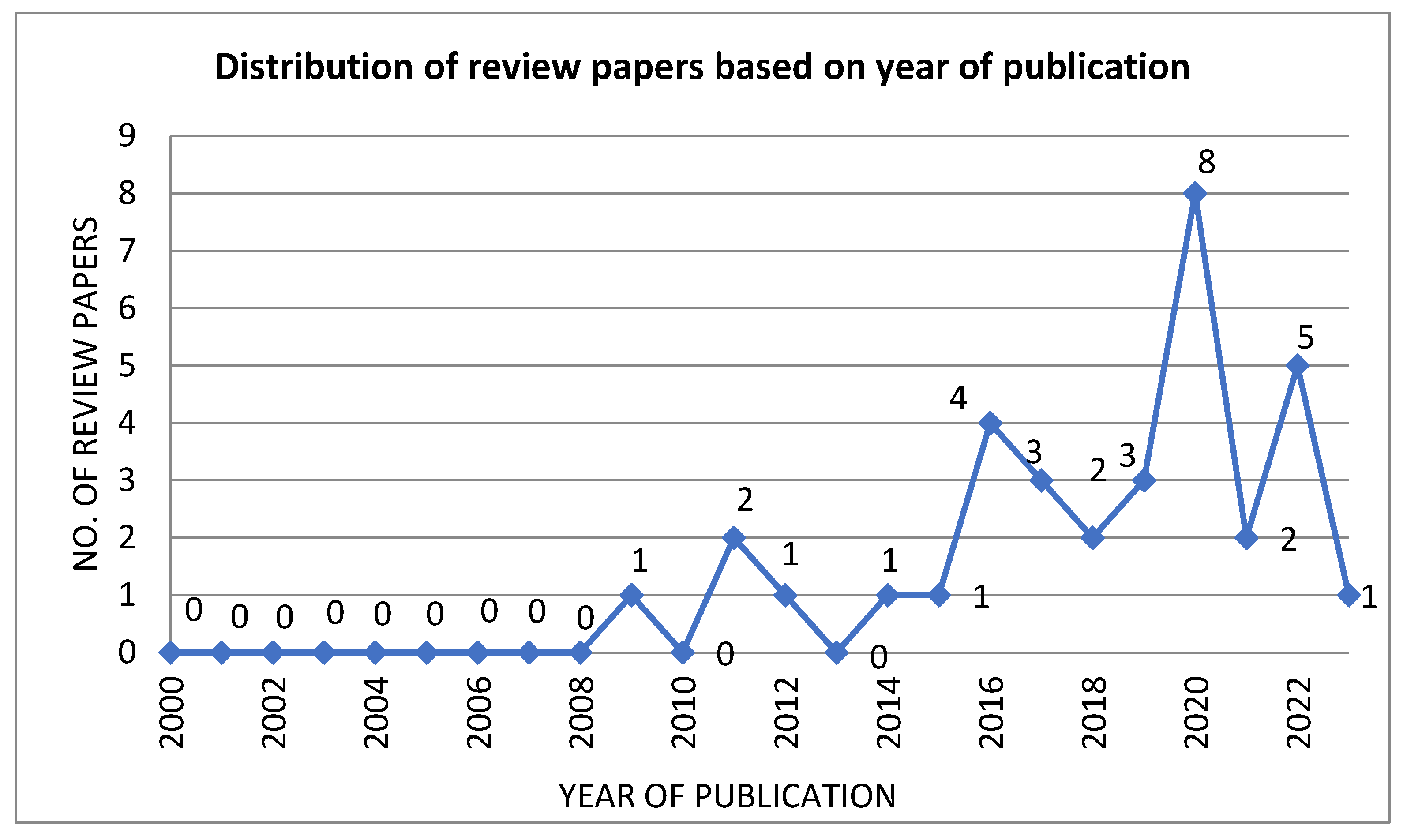
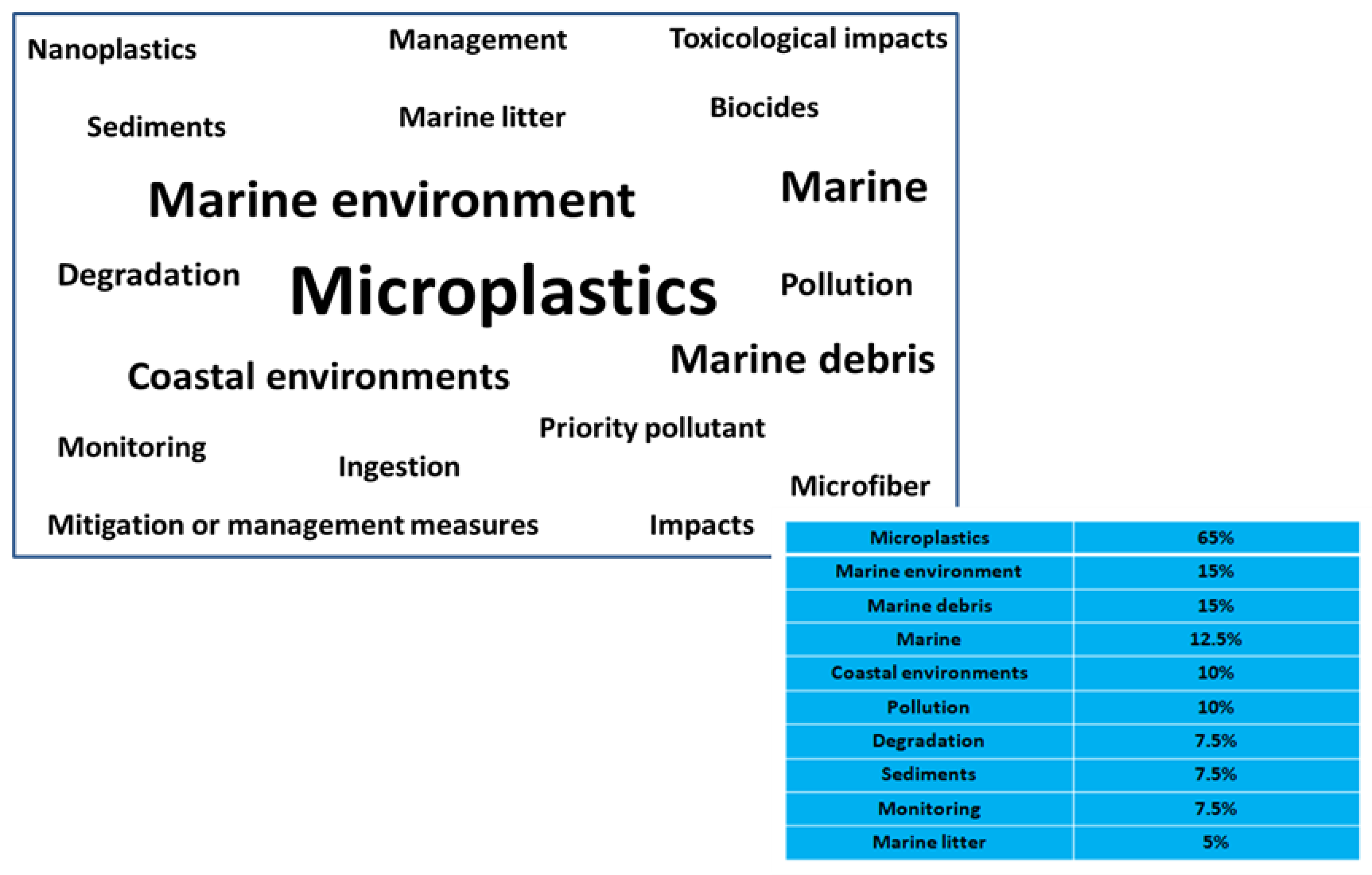

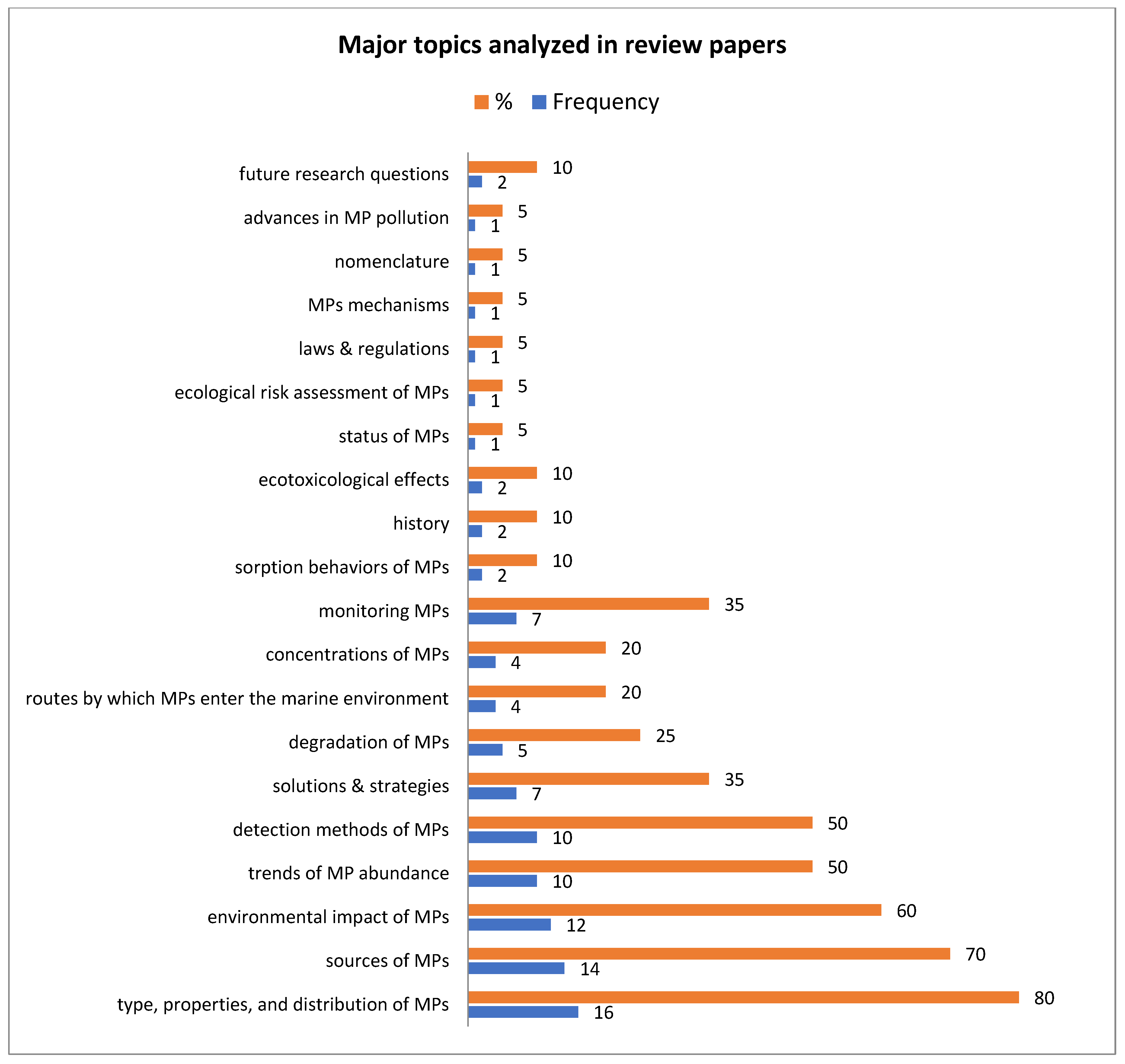
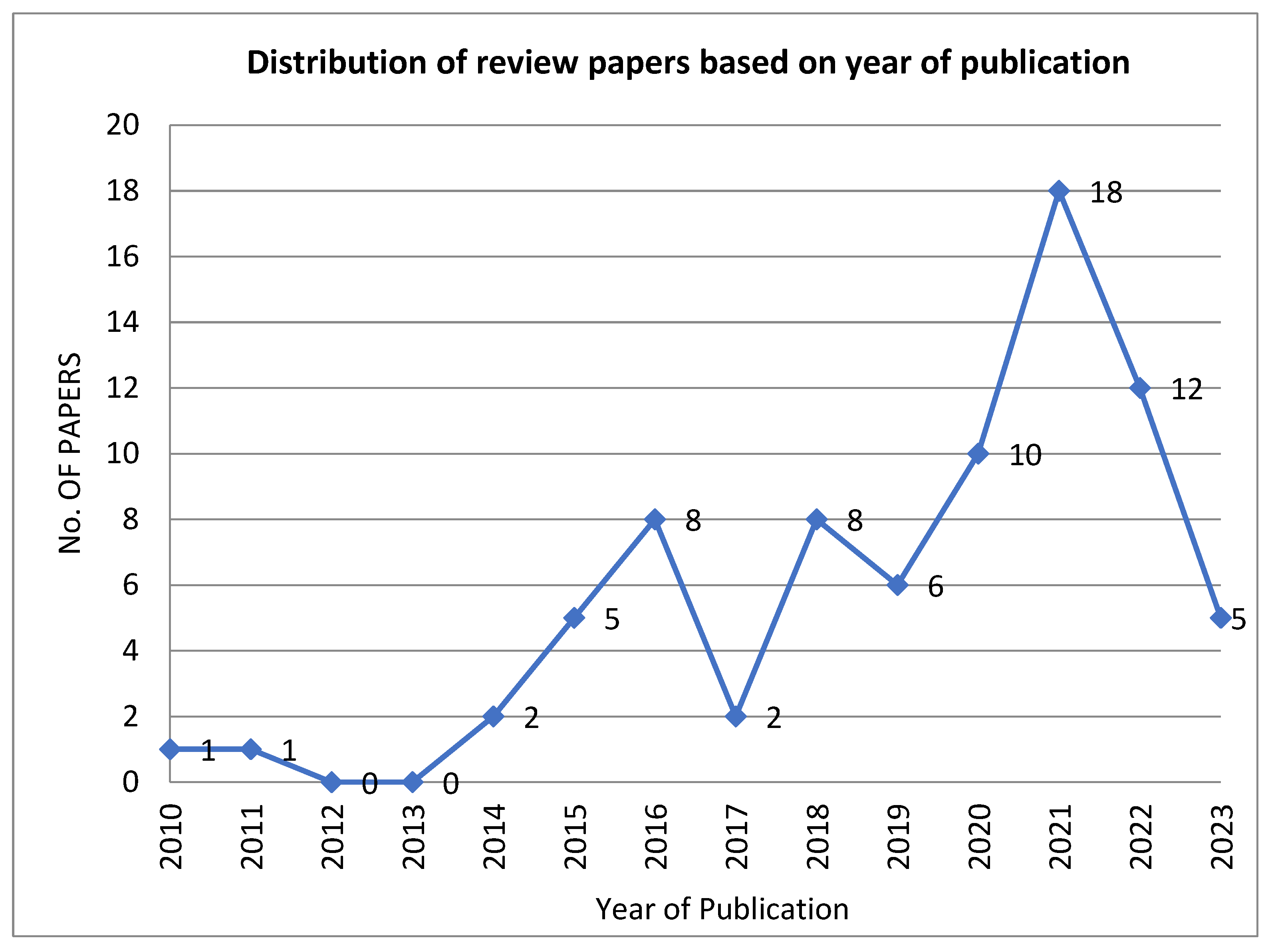
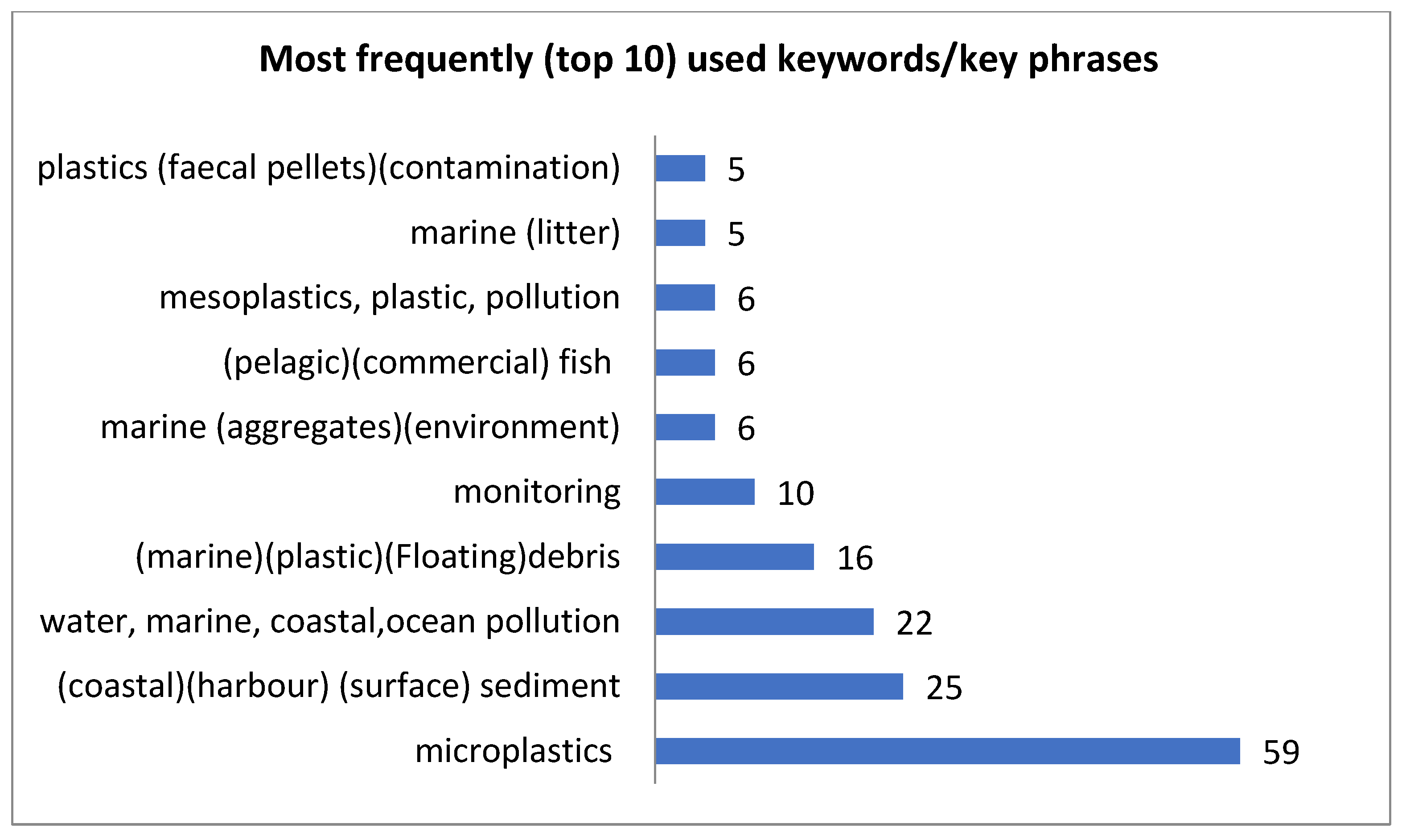
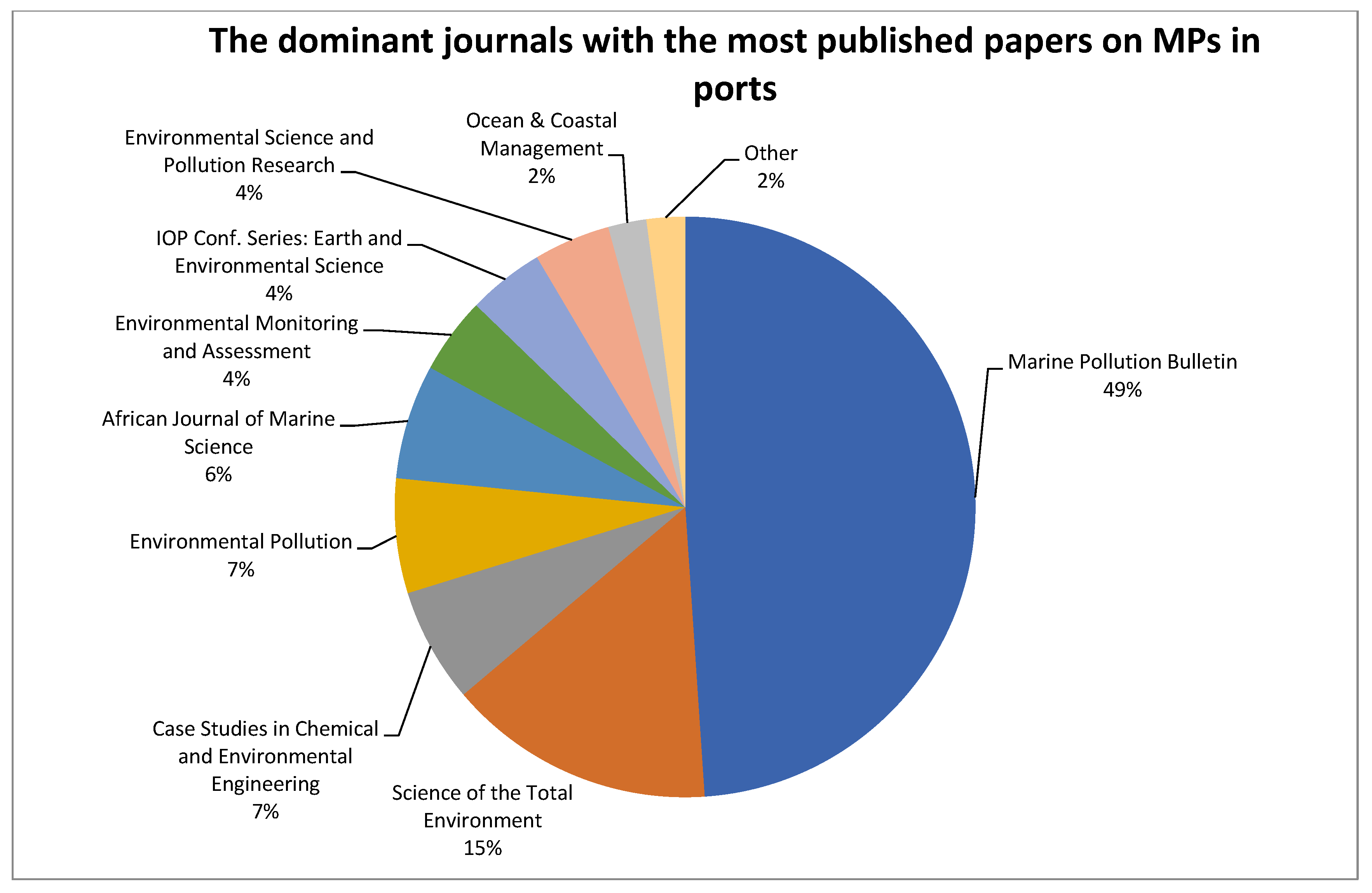
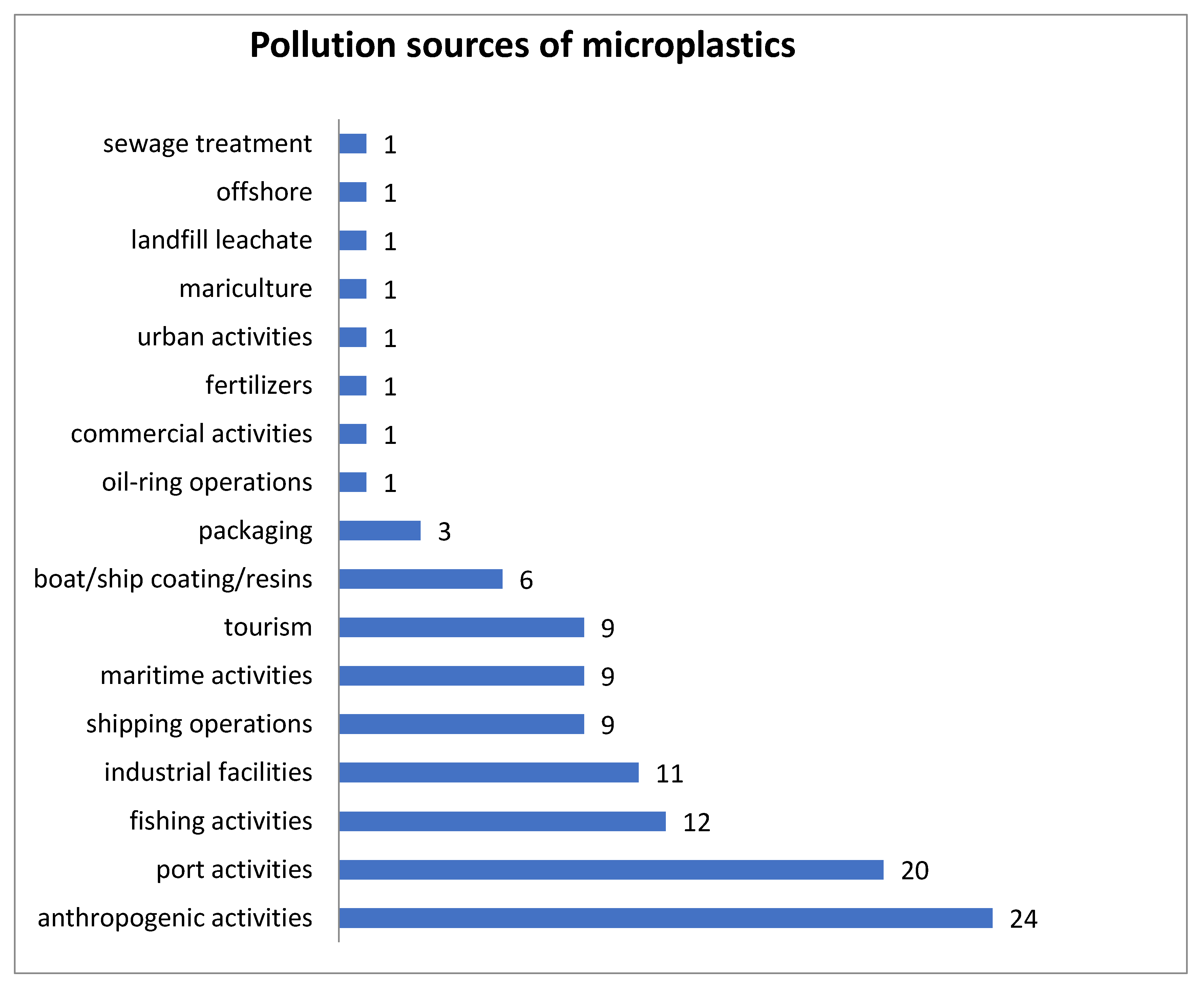
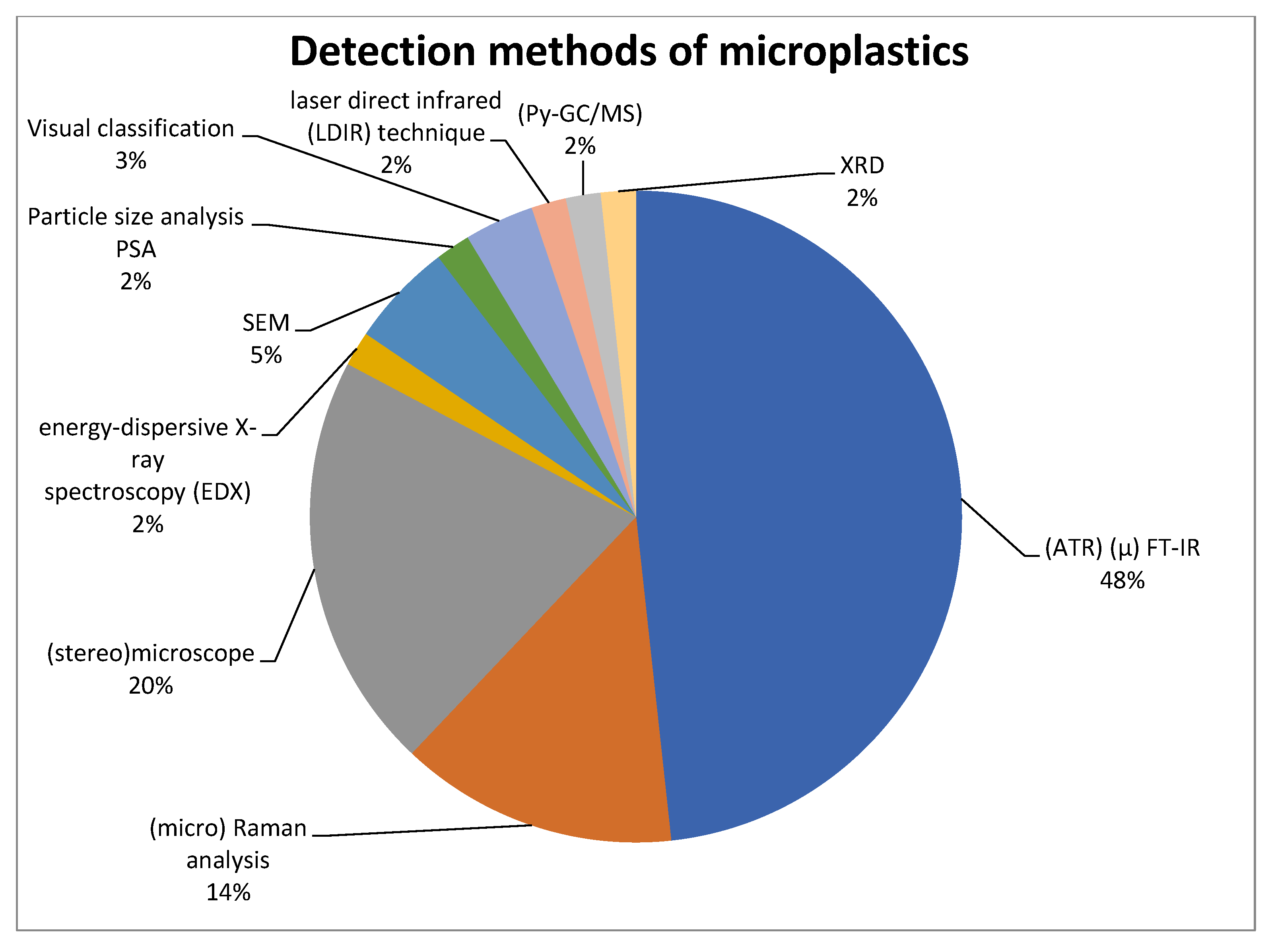
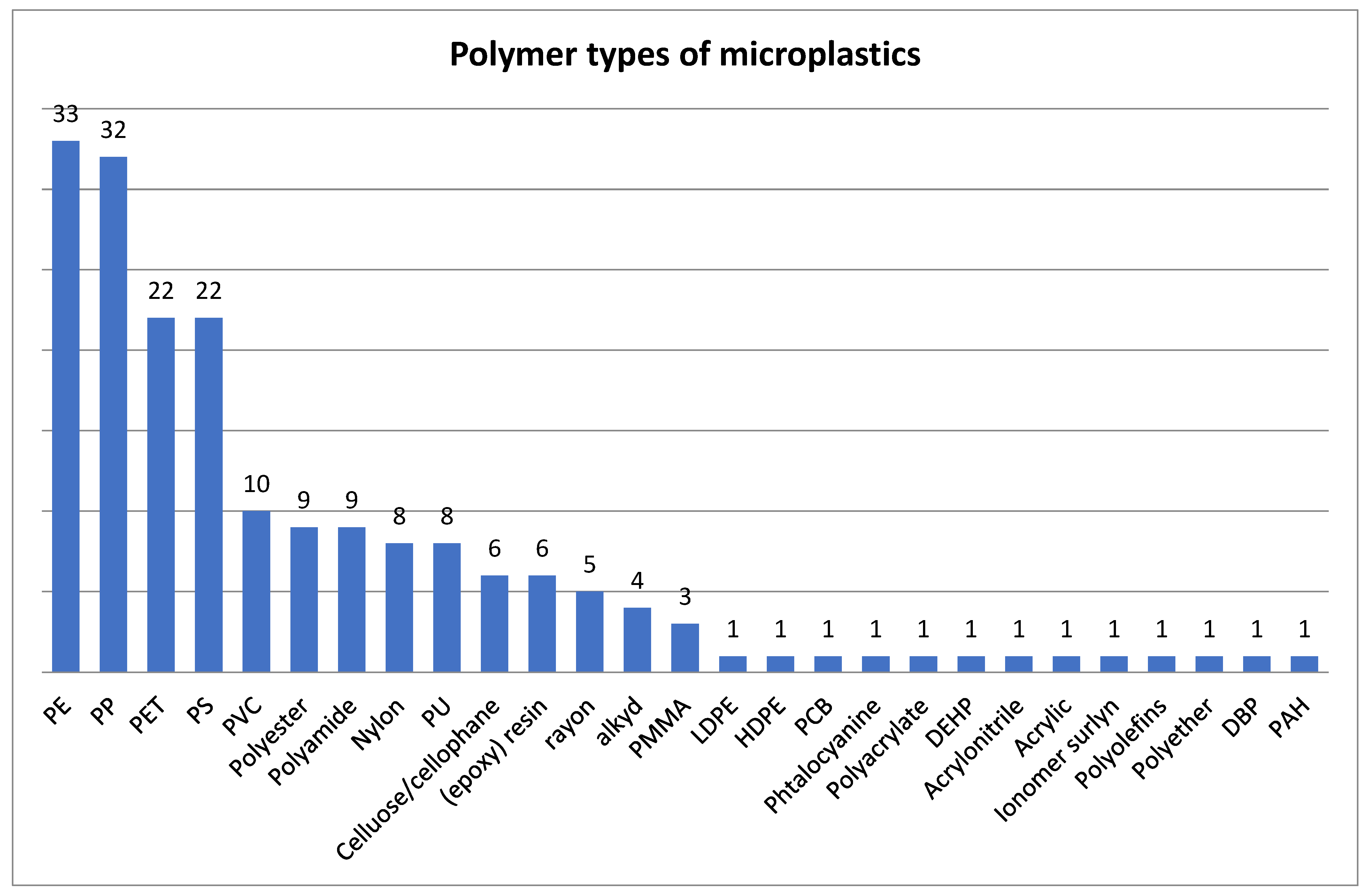
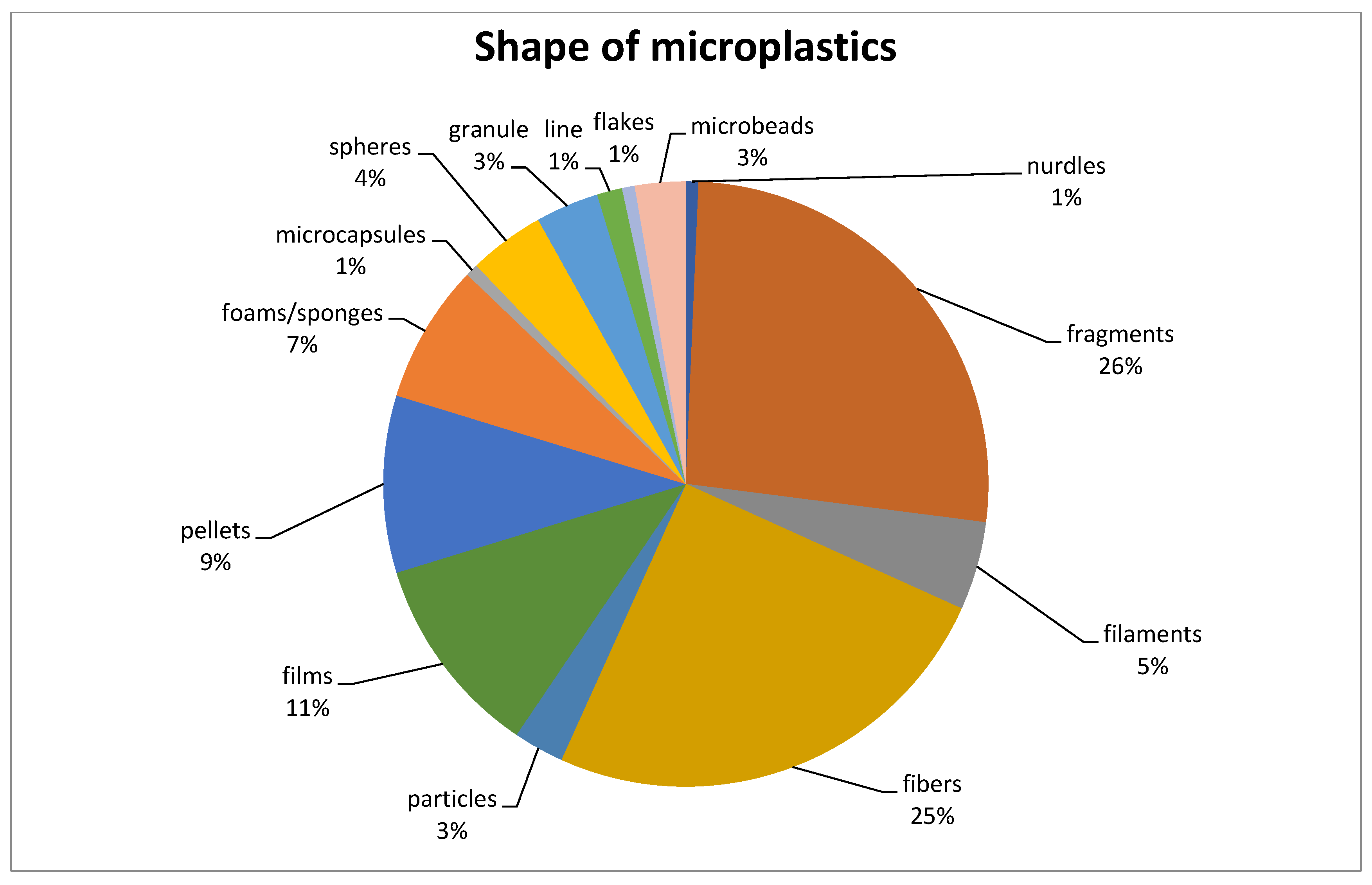
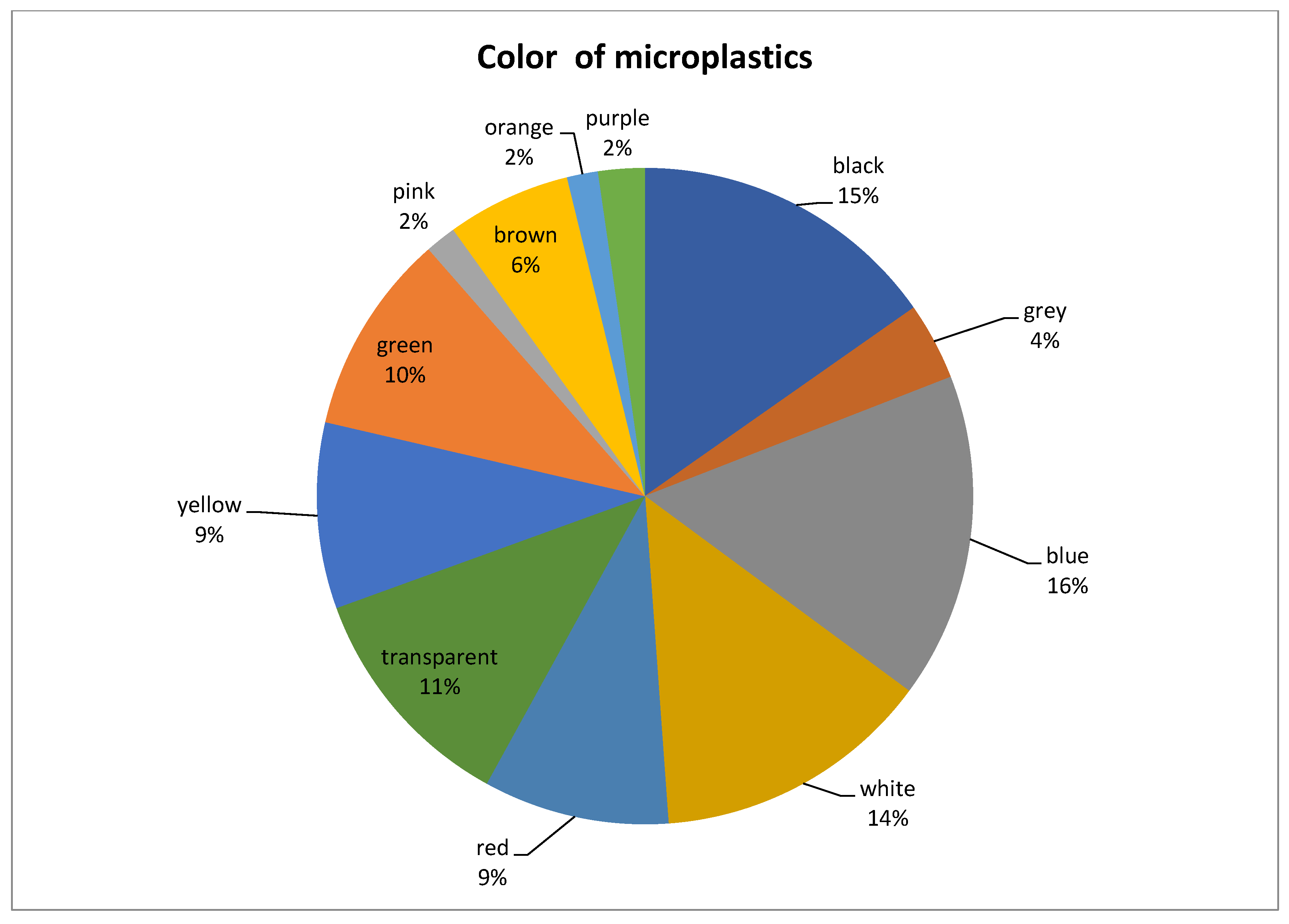
| Country | % |
|---|---|
| China | 41 |
| Germany | 27.3 |
| UK | 22.7 |
| Brazil | 18.8 |
| Nigeria, USA | 13.6 |
| Country | Publications on Microplastics in Ports and Coasts (%) |
|---|---|
| China | 17.2 |
| Brazil | 15.5 |
| Italy | 13.8 |
| UK | 12.0 |
| Germany | 10.3 |
| Japan, India, Norway, Australia | 8.6 |
| New Zealand, South Korea | 7.0 |
| South Africa, USA, Netherlands | 6.9 |
| Indonesia, Spain, France, Iran | 5.2 |
| Russia, Kenya, Croatia, Peru, Malaysia, Portugal, Egypt | 3.5 |
| Polymer Types | Shape | Size | Color/Texture | Pollution Source | Method of Detection | Location/Area | Ref. |
|---|---|---|---|---|---|---|---|
| polyesters, PS, PA, PVC, PP, and PE | Fragments and filaments | 5 mm | black or grey color | anthropogenic activities | ATR-FTIR analysis | Kuala Nerus coast and Kuantan port (Malaysia) | [60] |
| nylon, PU, PE, and PET | Filaments, fragments, and films | 1–5 mm | range of colors | multiple sources | FTIR | port of Piombino, port of Portoferraio (Italy) | [61] |
| Polyester, PE, alkyd resins, and PS | Fibers, hard plastic, and paint particles | (<2 mm) | - | industrial facilities | FTIR | Southeastern coast Sea (Korea) | [28] |
| PP, LDPE, PE, PS, PA, PMMA, cellophane, and acrylonitrile | Granular shape and fibrous | 125 μm–1.82 mm | - | anthropogenic activities, oil-rig installations, and shipping operations | ATR-FTIR | Qatar’s Exclusive Economic Zone coast | [62] |
| resins | Fragments and foams | 4–5 mm | - | industrial, commercial, and fishing activities | stereomicroscopy | Portuguese coast, fishing ports | [63] |
| rayon, PE, PP, PA, PET, PS, PMMA, and PU | Fibers, films, fragments, and pellet | <500 μm | - | river and sewage discharge and maritime activities, shipping | μ-FTIR | Sishili Bay, North Yellow Sea coast, China | [64] |
| PE, PP, and PET | Particles, pigments | 200–34,900 μm | - | - | Raman spectroscopy, energy-dispersive X-ray spectroscopy (EDX) | Malaysian coasts | [65] |
| PP, PE, PS, and nylon | Filaments and fragments | blue, white, and red | anthropogenic activities | Raman spectroscopy | Kuwait coastal areas | [66] | |
| Nylon, acrylic, and ionomer surlyn | Fibers, fragments, and pellets | >251 μm | - | anthropogenic activities, maritime activities | ATR-FTIR | Port Blair Bay, Andaman Islands, India | [67] |
| PE | Microcapsules and fragments | 2–3 mm | various colors | fertilizers | FTIR and SEM | Japanese coast | [68] |
| PE, PP, alkyd resin polyester, polyolefins, polyester, PS, and PA | Fibers and fragments | 5000 μm | - | - | FTIR | Vietnam coast | [69] |
| PE, PP, PS, and PET | Particles | 5 mm | - | maritime activities | ATR-FTIR particle size analysis PSA | Port of Durban, South Africa | [30] |
| PE, HDPE, and PP | Microfibers and particles (mostly fragments and films) | - | transparent and blue | swimming, walking, playing with sand, seaside camping, and fishing | binocular microscope | Busher port coastline. Persian Gulf, Iran | [70] |
| PP, PE, and polyester | Fibers, fragments, spheres, films, and foams | 0.25–5.0 mm | transparent, blue, yellow, black, and green | port activities and tourism economic activities | Raman | tropical bays (Manzanillo, Santiago, Navidad and Cuastecomates) of the central Mexican Pacific | [71] |
| Rayon and PET | Fibers, fragments, and films | 5 mm, 1 mm, 300 μm, and 45 μm. | white, green, black, yellow, and red | human activities, fish and port activities | FTIR-ALPHBROKER-Platinum-ATR spectrometer | Damietta and Port Said, Red and Mediterranean seas, Egypt | [72] |
| alkyds, epoxy resins, poly(acrylate-styrene), and PU | Foams, hard plastic fragments, paint fragments, and pellets | 1–5 mm | yellow, gray, and pink | urban and port activities, boat and ship coatings | optical stereomicroscope | Paranagua Estuarine port and coast, South Brazil | [73] |
| PE, PP, PET, polyester, nylon, PU, and resins | Filaments, fragments, granules, and spheres | 63–1000 μm | white, black, blue, grey, and brown | fish and port activities | X-ray diffraction (XRD), μ-Raman spectroscopy | Genoa port and a fishpond, Italy | [74] |
| HDPE, PS, PP, and PET. | Lines, fragments, pellets, foams, and fibers | <5 mm | - | tourism, anthropogenic, and maritime activities | FTIR | Port Blair, coast of the Andaman and Nicobar Islands, India | [75] |
| PET, PP, and PE | Films | <300 μm | white | human activities | Stereomicroscope, FTIR | Vava’u archipelago coast, Tonga | [76] |
| Polyether PU, PE, PP, and PS | Foams, pellets, fragments, flakes, fibers, films, and sponges | <1 mm | transparent, white, and yellow | high-intensity human activities, mariculture, tourism, and port construction | ATR-FTIR, SEM | coastline in Shandong province, east China | [77] |
| PP, PE, and PET | Fibers and fragments | 25–150 μm | black, red, and blue | port activities | Stereomicroscope, laser infrared imaging spectrometer | fishery port city in southern China | [78] |
| PP, PE paint, and epoxies | Fibers and fragments | 100 μm–5 cm | yellow and blue | Marine coating (boat paint and epoxy) | stereo zoom microscope | coast of South Andaman Island, India | [79] |
| PET and nylon | Fibers and spherules | 0.1–1 mm | white and black | fishing and fish processing activities along with intensive anthropogenic and industrial activities | FTIR | seaports (Port Jackson, Botany, Kembla, Newcastle, Yamba, and Eden) of New South Wales, Australia | [80] |
| PS and cellulose | Fibers, fragments, and films | ~1 mm | black/grey and blue | anthropogenic influence, fisheries, industrial, and port activities | Raman spectroscopy | Ushuaia Bay, Argentina | [81] |
| PA, PE, PET, PP, and cellulose | Fibers and fragments | ~1 mm | blue and transparent | industry—tourism, fishing, and shipping ports | FTIR | South Australian coastline | [82] |
| Nylon | Fibers | >1000 μm | black | landfill leachate | micro-Raman analysis | Bushehr port, Iran | [83] |
| PVC, PP, PE, PS, and PA | Fibers and fragments | 100–500 μm | - | human activities | μ-FTIR | port of Rimini Adriatic Sea, Italy | [84] |
| PET, PP, PP-co-PE, alkyd, cellophane, PU, PA, and rayon | Lines and fragments | <1 mm | black and white | harbor, industrial, activity and populated, tourist, residential, and aquaculture area | FTIR | Tanmen Port, China | [85] |
| PP, PS, PET, PVC, and PE | Fibers, fragments, films, and beads | 195–4780 μm | red, blue, black/brown, and transparent/white | Packaging, human activities, port and industrial, activity | ATR-FTIR and Micro-Raman spectroscopy | 7 port Cities in China, Japan, South Korea, Sri Lanka, Taiwan, Thailand, and Vietnam | [86] |
| Polyester, PP, PE, PET, PS, PVC, nylon, and PU | Fibers, fragments, films, foams, and pellets | 0.3–5 mm | white, transparent, and yellow | Fishing, human activities, construction of ships, insulating materials, fabrics. packaging | FTIR | Goa coast, India | [87] |
| PP, PS, PET, and PE | - | 63–500 μm | - | tourism, anthropogenic, and maritime activities | - | New Zealand coasts | [88] |
| LDPE | Pellets and fragments | ≤1 mm | white and transparent | Harbor activities | ATR-FTIR | Deep Bay, coast, Tolo Harbour, Tsing Yi coast and Victoria Harbour, Hong Kong, Japan | [89] |
| PE and PP | Fragments, fibers, foams, and micro-beads | ~250 μm | transparent, opaque, white, black, blue, green, red, yellow, or multi-colored | Harbor activities | (FTIR) | Kingston Harbour, Jamaica | [90] |
| PE, PP, PS, PET, PA, and PVC | Fibers, fragments, spherules, and granules | 0.1–0.5 mm | black, transparent, yellow, red, and blue | Harbor activities | Scanning electron microscopy/energy dispersive spectroscopy | Sanggou Bay, China | [91] |
| - | - | 1–5 mm | - | tourism, anthropogenic, and maritime activities | - | Sile Port, Black Sea Coast, Istanbul, Turkey | [92] |
| - | Fibers, fragments, and micro-beads | - | brown, grey, semitransparent, and green | anthropogenic pollution | optical microscopy | Fishing port, coast of Peru and Chile | [93] |
| - | Pellets | - | white, yellowish, orange, brown, and pigmented | Loading in harbor areas and transport by ships | Visual classification | Port of Santos, Brazil | [94] |
| - | Fibers, fragments, and films | - | - | human activities | FTIR | Fishing Ports in Java Island, Indonesia | [95] |
| PE, PVC, PET, PS, and PP | - | <200 μm, 200–500 μm, and >500 μm | - | anthropogenic pollution | laser direct infrared (LDIR) technique | Mediterranean marine samples | [96] |
| Rayon, PET, PS, PE, and PP | Fibers, fragments, granules, and films | <1 mm | transparent, purple, brown, white, black, blue, and red | human activities | m-ATR-FTIR and SEM-EDS | Qingdao and Dongying, China | [97] |
| - | Fragments, foams, fibers, films, pellets, and filaments | 1.6 ± 1.4 mm | - | human activities: packaging materials, and resins | - | Baseco Port Manila Bay, Philippines | [98] |
| Polychlorobiphenyls and PU | Fibers, fragments, Styrofoam, and pellets | <5 mm | yellow-brown, black, blue, red, and green | fishing and harbor activities | visual identification under a stereomicroscope | Guanabara Bay, Southeast Brazil | [99] |
| PP, PE, PS, PVC, PET, and PMMA | Fibers | ~125 μm | - | Offshore, industries, and ports activities | pyrolysis–gas chromatography–mass spectrometry/thermochemolysis (Py-GC/MS) | German Bight North Sea, Germany | [100] |
| Nylon, PET, and PP | Fibers, filaments, and fragments | <5 mm | - | port, industries, and residents activities | light microscope | Dumai Port, Indonesia | [101] |
| - | Foam and Styrofoam pieces, rope pieces, and fibers | 2 mm to 40 cm | - | Fishing, shipping, and touristic activities | visual sorting | Port of Cristo and Port of Colonia de Sant Jordi of the Island of Mallorca, Spain | [102] |
| - | Fibers, fragments, and films | 500–5000 μm | black, green, red, purple, blue, transparent, and brown | Anthropogenic activities: shipping, plastic production, port activities, and sewage treatment | - | Tudor, Port Reitz, and Mida creeks, Kenya | [103] |
| - | Fibers, fragments, and films | - | - | Tourism and industry activities | Stereo Microscope | Kendari Archipelago Harbor, Indonesia | [104] |
| PVC and PET | Fibers, fragments, and nurdles | 63–5000 μm | black and grey | Human activity and port activity | Bestscope dissecting microscope | Richard’s Bay Harbour, Durban Harbour, South Africa | [105] |
| - | Fibers | <5 mm | red, yellow, black, pink, orange, purple, green, blue, and transparent | Human activities | dissecting microscope | Tudor, Port Reitz, and Mida creeks, Kenya | [106] |
| PP, PE, phenoxy resin, PS, polyester, and synthetic rubber | Fragments, spherules, and fibers | <1 mm | white, blue, green, and red | Harbor activities and ship paint resin | FTIR | Jinhae Bay, o southern coast of Korea | [107] |
| - | Fragments and pellets | <1 mm | white, blue, brown, and green | Port facilities | stereomicroscope | Northeast coast of Brazil | [108] |
| PCBs | Filaments | <5 mm | - | Port activities | stereomicroscope | Grand Harbour Valletta, Malta | [109] |
| PVC, rayon, PE, polyester, PS, and cellulose | Fibers, pellets, and plastic fragments | - | black, blue, or white | fishers and maritime ports activities | FTIR | coast of Asturias, Spain | [110] |
| alkyds and poly(acrylate-styrene) | Fragments, spherules, and fibers | <1 mm | green, blue, and white | Harbor activities, ship paint resin, and ship coatings | FTIR | southern coast of Korea | [111] |
| PS, PE, and PP | Microbeads and pellets | <1 mm; 1–2 mm; or 2–5 mm | white, transparent, red, blue, and green | estuarine and harbor environments | optical/fluorescence imaging and micro-Raman spectroscopy | coastlines in the Canterbury region of New Zealand | [112] |
| PE and PP | Fragments and pellets | 1–5 mm | - | human activities | FTIR | Bristol Channel, UK | [113] |
| PP-co-PE, PA, PE, PET, PP, and PVC | Fibers, thin films, and fragments | <0.5 mm | blue, black, red, yellow, green, and white | marine fishery and port transportation | FTIR | Tianjin coastal waters, China | [114] |
Disclaimer/Publisher’s Note: The statements, opinions and data contained in all publications are solely those of the individual author(s) and contributor(s) and not of MDPI and/or the editor(s). MDPI and/or the editor(s) disclaim responsibility for any injury to people or property resulting from any ideas, methods, instructions or products referred to in the content. |
© 2023 by the authors. Licensee MDPI, Basel, Switzerland. This article is an open access article distributed under the terms and conditions of the Creative Commons Attribution (CC BY) license (https://creativecommons.org/licenses/by/4.0/).
Share and Cite
Belioka, M.-P.; Achilias, D.S. Microplastic Pollution and Monitoring in Seawater and Harbor Environments: A Meta-Analysis and Review. Sustainability 2023, 15, 9079. https://doi.org/10.3390/su15119079
Belioka M-P, Achilias DS. Microplastic Pollution and Monitoring in Seawater and Harbor Environments: A Meta-Analysis and Review. Sustainability. 2023; 15(11):9079. https://doi.org/10.3390/su15119079
Chicago/Turabian StyleBelioka, Maria-Paraskevi, and Dimitrios S. Achilias. 2023. "Microplastic Pollution and Monitoring in Seawater and Harbor Environments: A Meta-Analysis and Review" Sustainability 15, no. 11: 9079. https://doi.org/10.3390/su15119079






